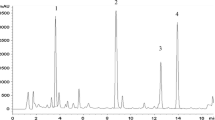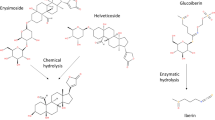Abstract
Leaf explants of Stevia rebaudiana Bertoni (Compositae), an herb which produces the sweet ent-kaurene glycoside stevioside, were cultured in Murashige and Skoog medium with vitamins, sucrose (30 g l−1), agar (0.9% w/v) and supplemented with naphthaleneacetic acid (NAA, 0.5 mg l−1) and benzylaminopurine (BAP, 0.5 mg l−1). These conditions yielded friable callus cultures. Differentiation of the callus tissue was then achieved by eliminating the agar and modulating the medium's hormone concentrations. Thus, medium containing increased auxin concentration (1.0 mg l−1) and no cytokinin or increased cytokinin (1.0 mg l−1) and no auxin yielded root or shoot cultures respectively. Supplementation of the shoot medium with NAA (1.0 mg ml−1) induced shoot cultures to grow roots thereby differentiating into rooted-shoot cultures. Only the rooted-shoot cultures tasted sweet. Feedings of [2-14C]acetic acid to callus, shoot or rooted-shoot cultures demonstrated that only the rooted-shoot cultures are capable of de novo biosynthesis of the aglycone moiety of stevioside (steviol). In addition, [methyl-3H(N)steviol feedings to shoot or rooted-shoot cultures illustrated that both types of cultures are capable of the glycosylation reaction. The ability of these tissues to glycosylate steviol to stevioside was also demonstrated employing crude enzyme preparations derived from shoot or rooted-shoot cultures. These results suggest that stevioside biosynthesis is a function of tissue differentiation since both roots and leaves are required for cultured S. rebaudiana to biosynthesize stevioside from acetate, while the final biosynthetic steps can be performed at all levels of differentiation.
Similar content being viewed by others
References
Soejarto DD, Compadre CM, Medon PJ, Kamath SK & Kinghorn AD (1983) Potential sweetening agents of plant origin. II. Field search for sweet-tasting Stevia species. Econ Bot 37: 71–79
Kinghorn AD & Soejarto DD (1985) Current status of stevioside as a sweetening agent for human use. In: Wagner H, Hikino H & Farnsworth NR (Eds) Economic and Medicinal Plant Research, Vol 1(pp 1–52). Academic Press, London
Bell F (1954) Stevioside: A unique sweetening agent. Chem Ind (London) 32: 897–898
Pezzuto JM, Compadre CM, Swanson SM, Nanayakkara NPD & Kinghorn AD (1985) Metabolically activated steviol, the aglycone of stevioside is mutagenic. Proc Nat Acad Sci USA 82: 2478–2482
Pezzuto JM, Nanayakkara NPD, Compadre CM, Swanson SM, Kinghorn AD, Guenthner TM, Sparnins VL & Lam LKT (1986) Characterization of bacterial mutagenicity mediated by 13-hydroxy-ent-kaurenoic acid (steviol) and several structurally related derivatives and evaluation of potential to induce glutathione-S-transferase in mice. Mutat Res 169: 93–103
Pezzuto JM (1986) Chemistry, metabolism and biological activity of steviol (ent-13-hydroxykaur-16-en-19-oic acid), the aglycone of stevioside. In: Rahman AU & Le Quesne PW (Eds) Trends in Natural Products Chemistry 1986 (pp 371–386). Elsevier, Amsterdam
Ruddat M, Lang A & Mosettig E (1963) Gibberellin activity of steviol, a plant terpenoid. Naturwissenschaften 50: 23–24
Bearder JR, MacMillan J, Wels CM & Phinney BO (1975) The metabolism of steviol to 13-hydroxylated ent-gibberellins and ent-kaurenes. Phytochemistry 14: 1741–1748
Gianfanga T, Zeevaart JAD & Lusk WJ (1983) Synthesis of [2H]-gibberellins from the fungus Gibberella fujikuroi. Phytochemistry 22: 427–430
Marashige T & Skoog F (1962) A revised medium for rapid growth and bioassays with tobacco tissue cultures. Physiol Plant 15: 473–479
Kinghorn AD, Soejarto DD, Nanayakkara NPD, Compadre CM, Makapugay HC, Hovanec-Brown JM, Medon PJ & Kamath SK (1984) A phytochemical screening procedure for sweet ent-kaurene glycoside in the genus Stevia. J Nat Prod 47: 439–444
Makapugay HC, Nanayakkara NPD & Kinghorn AD (1984) Improved high-performance liquid chromatographic separation of the Stevia rebaudiana sweet diterpene glycoside using linear gradient elution. J Chromatogr 283: 390–395
Bradford M (1976) A rapid and sensitive method for the quantitations of microgram quantities of protein utilizing the principal of protein-dye binding. Anal Biochem 72: 248–254
Handro W, Hell KG & Gilberto BK (1977) Tissue culture of Stevia rebuadiana, a sweetening plant. Planta Med 32: 115–117
Komatsu K, Nozaki W, Takemura M & Nakaminami M (1976) Production of natural sweetener. Jpn Kokai Tokyo Koho 1976–19: 169; (1976) Chem. Abstr. 84: 163174h
Lee KR, Park JR, Choi BS, Han JS, Oh SL & Yamada Y (1982) Studies on the callus culture of Stevia as a new sweetening source and formation of stevioside. Hanguk Sikp'um Kwahakhoe Chi 14: 179–183
Hsing YI, Su WF & Chang WC (1983) Accumulation of stevioside and rebaudioside A in callus culture of Stevia rebaudiana. Bot Bull Acad Sin 24: 115–119
Tamura Y, Nakamura S, Fukui H & Tabata M (1984) Comparison of Stevia plants grown from seeds, cuttings and stem-tip cultures for growth and sweet diterpene glycosides. Plant Cell Rep 3: 180–182
Miyagawa H, Fujioka N, Kohda H, Yamasaki K, Taniguchi K & Tanaka R (1986) Studies on the tissue culture of Stevia rebaudiana and its components (II). Introduction of shoot primordia. Planta Med 52: 321–323
Ferreira CM & Handro W (1988) Micropropagation of Stevia rebaudiana through leaf explants from adult plants. Planta Med 54: 157–160
Kotani C (1980) Steviosides. Jpn Kokai Tokkyo Koho 1980–19: 009; (1980) Chem Abstr 93: 4133
Author information
Authors and Affiliations
Rights and permissions
About this article
Cite this article
Swanson, S.M., Mahady, G.B. & Beecher, C.W.W. Stevioside biosynthesis by callus, root, shoot and rooted-shoot cultures in vitro . Plant Cell Tiss Organ Cult 28, 151–157 (1992). https://doi.org/10.1007/BF00055510
Received:
Accepted:
Issue Date:
DOI: https://doi.org/10.1007/BF00055510




